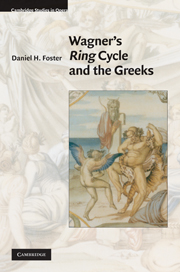Book contents
- Frontmatter
- Contents
- List of musical examples
- Preface
- Acknowledgments
- Introduction
- Part I Epic
- Part II Lyric
- 5 Introduction: what is lyric?
- 6 Orpheus and lyric liberation
- 7 First-person opera and lyric identity
- 8 Lyric and the rebirth of tragedy
- Part III Drama
- Epilogue: Time, the Ring, and Performance Studies
- Appendices: Wagner's primary and secondary sources
- Notes
- Bibliography
- Index
5 - Introduction: what is lyric?
from Part II - Lyric
Published online by Cambridge University Press: 07 May 2010
- Frontmatter
- Contents
- List of musical examples
- Preface
- Acknowledgments
- Introduction
- Part I Epic
- Part II Lyric
- 5 Introduction: what is lyric?
- 6 Orpheus and lyric liberation
- 7 First-person opera and lyric identity
- 8 Lyric and the rebirth of tragedy
- Part III Drama
- Epilogue: Time, the Ring, and Performance Studies
- Appendices: Wagner's primary and secondary sources
- Notes
- Bibliography
- Index
Summary
In Greek epic poetry the epic poet's personal identity tends to be superseded by national identity. We rarely hear Homer speak in the first person. From the very beginnings of both his epics he tells us that it is not he who is singing but the muse singing through him. In the case of lyric poetry, though, the opposite is more often the case. Lyric turns epic on its head. In epic the individual disappears into the national, but in lyric the nation is summed up in the individual. The lyric poet links the universal and the particular through his or her own subjectivity in order to defend each poem against the forces of incoherence and abstraction. His or her personal identity usually forms the unifying center of a given lyric poem – the sun to its orbiting planets or, perhaps more appropriately, the black hole to anything within its gravitational pull. But because personal identity, with all its idiosyncratic quirks, twists, and turns, can manifest itself in literally infinite ways, it might seem impossible to establish concrete criteria with which to define the genre of lyric, criteria that would extend beyond the simple observation that this genre is somehow more personal than epic. Realizing this difficulty, Northrop Frye, in his Anatomy of Criticism, gives us a practical if somewhat unserious lesson on the problems of classifying lyric poetry: “we call Shelley's Ode to the West Wind a lyric, perhaps because it is a lyric; if we hesitate to call Epipsychidion a lyric, and have no idea what it is, we can always call it the product of an essentially lyrical genius.
- Type
- Chapter
- Information
- Wagner's Ring Cycle and the Greeks , pp. 111 - 121Publisher: Cambridge University PressPrint publication year: 2010



